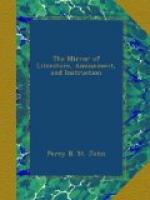The present cathedral is represented to have been merely the church of the monastery, which was entirely rebuilt in the commencement of the fourteenth century. The style of architecture in the different parts of this cathedral is accurately discriminated in the following account from the pen of Bishop Littleton, F.S.A.:—“The lower parts of the chapter house walls,” says he, “together with the door-way and columns at the entrance of the chapter-house, may be pronounced to be of the age of Stephen, or rather prior to his reign, being fine Saxon architecture. The inside walls of the chapter-house have round ornamental arches intersecting each other. The cathedral appears to be of the same style of building throughout, and in no part older than Edward the First’s time, though some writers suppose the present fabric was begun in king Stephen’s time; but not a single arch, pillar, or window agrees with the mode which prevailed at that time. The great gateway leading into the College Green is round-arched, with mouldings richly ornamented in the Saxon taste.” From this account it appears probable that the chapter-house and gateway are all the present remains of the ancient monastery. The mutilations which the cathedral of Bristol has undergone, are not entirely to be referred to the era of the dissolution of the monasteries, since this structure suffered very considerably during the period of the civil wars. The ruthless soldiers discovered their barbarism by violating the sacred tombs of the dead, and by offering every indignity which they supposed would be considered a profanation of the places which the piety of their ancestors consecrated to religion. At such instances of the violence of civil factions, the sensitive mind shudders with disgust.
The cathedral of Bristol is rich in monumental tributes to departed worth. Among them is an elegant monument, by Bacon, to Mrs. Elizabeth Draper, the Eliza of Sterne; and the classical tomb of the Hendersons. Here, too, rests Lady Hesketh, the friend of Cowper; Powell, of Covent Garden Theatre; besides branches of the Berkeley family, and various abbots.
The bishopric of Bristol is the least wealthy ecclesiastical promotion which confers the dignity of a mitre. Its revenue is generally stated to amount to no more than five or six hundred pounds per annum. In the list of bishops are Fletcher, father of the celebrated dramatist, the colleague of Beaumont; he attended Mary Queen of Scots on the Scaffold; Lake, one of the seven bishops committed to the Tower in the time of James I.; Trelawney, a familiar name in the events of 1688; Butler, who materially improved the episcopal palace of Bristol; Conybeare and Newton, names well known in literary history; with the erudite Warburton, whose name occurs in the list of deans of Bristol.
* * * * *
DEBTOR AND CREDITOR.[1]
The time is out of joint.—Hamlet.




